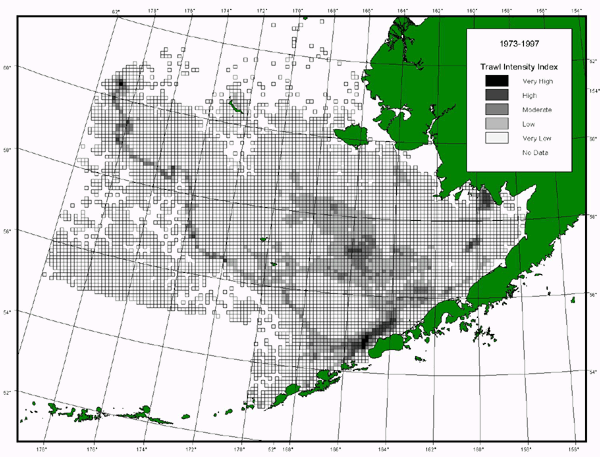 The Bering Sea has experienced rapid and intensive development of commercial bottom trawl fisheries. Because of good record keeping and the relatively brief history of fishing in the area, it is possible to reconstruct the spatial and temporal patterns of exploitation. For purposes of this discussion, the Bering Sea is comprised of catch reporting areas north of the Alaska Peninsula, excluding the western Aleutian Islands (areas 541, 542, 543).
The Bering Sea has experienced rapid and intensive development of commercial bottom trawl fisheries. Because of good record keeping and the relatively brief history of fishing in the area, it is possible to reconstruct the spatial and temporal patterns of exploitation. For purposes of this discussion, the Bering Sea is comprised of catch reporting areas north of the Alaska Peninsula, excluding the western Aleutian Islands (areas 541, 542, 543).
For the period 1973-1997, a total of 412,040 records of bottom trawls in the Bering Sea were obtained from the NMFS Observer database (NORPAC). Bottom trawls by the domestic trawl fleet (1986-1997; n=182,705) were selected according to gear type information recorded in the field. Bottom trawls by the joint venture (1980-1990; n=101,376) and foreign (1973-1989; n=127,959) fleets were selected based on presence of benthic organisms (e.g. crabs, snails, sea stars) in the catch, because gear information is not available.
Two general spatial patterns are apparent when the historical trawl data are summarized on a 10 km grid (Figure 1). First, virtually all areas of the Bering Sea have experienced some degree of exposure to bottom trawls. Second, there is substantial variability in the intensity of exposure, when one considers the number of trawls made per unit area. These patterns reflect the non-random behavior of fishing fleets, which is based on historical patterns of performance and regulatory restrictions. Relatively heavy trawling has occurred along the shelf edge, along the Alaska Peninsula near Unimak Island and in Togiak Bay. The primary composition of the catch in these three areas was pollock, Pacific cod and Greenland turbot; Pacific cod and pollock; and yellowfin sole (Fritz et al., 1998).

